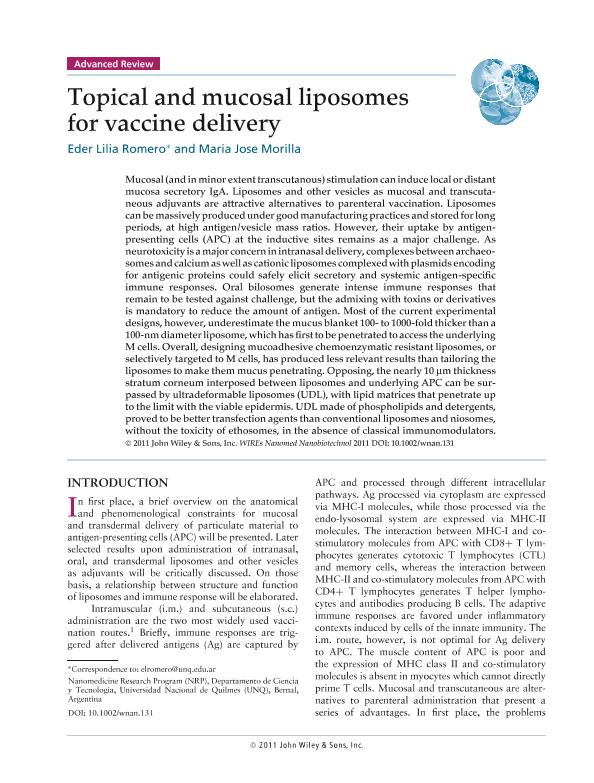Mostrar el registro sencillo del ítem
dc.contributor.author
Romero, Eder Lilia

dc.contributor.author
Morilla, María José

dc.date.available
2023-03-29T14:19:17Z
dc.date.issued
2011-02
dc.identifier.citation
Romero, Eder Lilia; Morilla, María José; Topical and mucosal liposomes for vaccine delivery; John Wiley & Sons; Wiley Interdisciplinary Reviews: Nanomedicine and Nanobiotechnology; 3; 4; 2-2011; 356-375
dc.identifier.issn
1939-5116
dc.identifier.uri
http://hdl.handle.net/11336/191991
dc.description.abstract
Mucosal (and in minor extent transcutanous) stimulation can induce local or distant mucosa secretory IgA. Liposomes and other vesicles as mucosal and transcutaneous adjuvants are attractive alternatives to parenteral vaccination. Liposomes can be massively produced under good manufacturing practices and stored for long periods, at high antigen/vesicle mass ratios. However, their uptake by antigen-presenting cells (APC) at the inductive sites remains as a major challenge. As neurotoxicity is a major concern in intranasal delivery, complexes between archaeosomes and calcium as well as cationic liposomes complexed with plasmids encoding for antigenic proteins could safely elicit secretory and systemic antigen-specific immune responses. Oral bilosomes generate intense immune responses that remain to be tested against challenge, but the admixing with toxins or derivatives is mandatory to reduce the amount of antigen. Most of the current experimental designs, however, underestimate the mucus blanket 100- to 1000-fold thicker than a 100-nm diameter liposome, which has first to be penetrated to access the underlying M cells. Overall, designing mucoadhesive chemoenzymatic resistant liposomes, or selectively targeted to M cells, has produced less relevant results than tailoring the liposomes to make them mucus penetrating. Opposing, the nearly 10 μm thickness stratum corneum interposed between liposomes and underlying APC can be surpassed by ultradeformable liposomes (UDL), with lipid matrices that penetrate up to the limit with the viable epidermis. UDL made of phospholipids and detergents, proved to be better transfection agents than conventional liposomes and niosomes, without the toxicity of ethosomes, in the absence of classical immunomodulators.
dc.format
application/pdf
dc.language.iso
eng
dc.publisher
John Wiley & Sons

dc.rights
info:eu-repo/semantics/openAccess
dc.rights.uri
https://creativecommons.org/licenses/by-nc-sa/2.5/ar/
dc.subject
TOPICAL
dc.subject
MUCOSAL
dc.subject
IMMUNIZATION
dc.subject
LIPOSOMES
dc.subject.classification
Otras Nanotecnología

dc.subject.classification
Nanotecnología

dc.subject.classification
INGENIERÍAS Y TECNOLOGÍAS

dc.title
Topical and mucosal liposomes for vaccine delivery
dc.type
info:eu-repo/semantics/article
dc.type
info:ar-repo/semantics/artículo
dc.type
info:eu-repo/semantics/publishedVersion
dc.date.updated
2023-03-28T14:09:45Z
dc.journal.volume
3
dc.journal.number
4
dc.journal.pagination
356-375
dc.journal.pais
Estados Unidos

dc.journal.ciudad
Nueva Jersey
dc.description.fil
Fil: Romero, Eder Lilia. Consejo Nacional de Investigaciones Científicas y Técnicas; Argentina. Universidad Nacional de Quilmes. Departamento de Ciencia y Tecnología; Argentina
dc.description.fil
Fil: Morilla, María José. Consejo Nacional de Investigaciones Científicas y Técnicas; Argentina. Universidad Nacional de Quilmes. Departamento de Ciencia y Tecnología; Argentina
dc.journal.title
Wiley Interdisciplinary Reviews: Nanomedicine and Nanobiotechnology
dc.relation.alternativeid
info:eu-repo/semantics/altIdentifier/url/https://wires.onlinelibrary.wiley.com/doi/10.1002/wnan.131
dc.relation.alternativeid
info:eu-repo/semantics/altIdentifier/doi/http://dx.doi.org/10.1002/wnan.131
Archivos asociados
